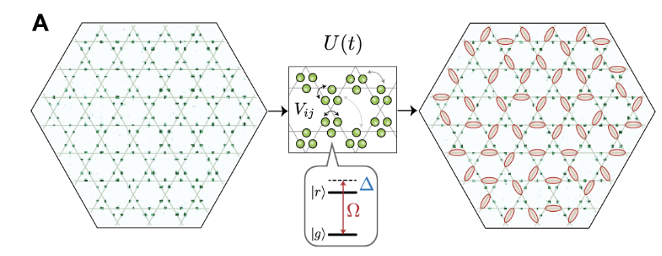QSA scientists used a neutral atom quantum simulator to observe the onset of a quantum spin liquid phase, demonstrating how these flexible systems can be used to experimentally explore topological materials that have been a major focus in physics for the past several decades.
The Science: Over the last few years, atomic physicists have developed optical tweezer techniques for arranging large numbers of neutral atoms in arbitrary 2D geometric patterns and then manipulating them with lasers. By exploiting this flexibility, QSA researchers were able to construct a kagome lattice with 219 rubidium atoms to study how topological order emerges from non-local entanglement within the lattice, and in doing so simulate a quantum spin liquid (QSL). Interactions between atoms were mediated by Rydberg blockade and led to topologically non-trivial states, which were detected after a period of time evolution by measuring the state of the atoms.

The Impact: Classical simulations of quantum dynamics for important problems in physics, such as topological materials, are not tractable due to the computational complexity of the problem. In a first-of-its-kind quantum simulation, QSA researchers show that neutral atom quantum computers can simulate topological behavior in quantum liquids, delivering a new platform to understand and control complex correlated materials.
Summary: Motivated by theoretical work carried out over the past five decades, a broad search has been underway to identify signatures of quantum spin liquids (QSLs) in correlated materials. These types of exotic phases feature long-range quantum entanglement and are computationally intractable for classical computers. In this research, QSA researchers used a neutral atom quantum simulator to show signatures of a QSL, highlighting the potential of quantum computing for scientific discovery and practical material applications.
Contact:
Markus Greiner – mgreiner@fas.harvard.edu
Vladan Vuletić – vuletic@mit.edu
Mikhail Lukin – lukin@physics.harvard.edu
Institutions: Harvard, University of Innsbruck, QuEra, Institute for Advanced Study, MIT
Citation: Semeghini, G. et al., Probing topological spin liquids on a programmable quantum simulator. Science 374, 6572, 1242-1247 (2021)
Funding Acknowledgement: We acknowledge financial support from the Center for Ultracold Atoms, the National Science Foundation, the U.S. Department of Energy (DE-SC0021013 and LBNL QSA Center), the Army Research Office MURI, the DARPA ONISQ program, QuEra Computing, and Amazon Web Services. We further acknowledge support from the Max Planck/Harvard Research Center for Quantum Optics fellowship (to G.S.), the National Defense Science and Engineering Graduate (NDSEG) fellowship (to H.L.), Gordon College (to T.T.W,), the NSF Graduate Research Fellowship Program (grant DGE1745303) and The Fannie and John Hertz Foundation (to D.B.), the Harvard Quantum Initiative Postdoctoral Fellowship in Science and Engineering (to R.V.), the Simons Collaboration on Ultra-Quantum Matter (Simons Foundation grant 651440 to R.V., A.V., and S.S.). R.S. and S.S. were supported by the U.S. Department of Energy under grant DE-SC0019030. The DMRG simulations were performed by using the Tensor Network Python (TeNPy) package developed by J. Hauschild and F. Pollmann (36) and were run on the FASRC Cannon and Odyssey clusters supported by the FAS Division of Science Research Computing Group at Harvard University.